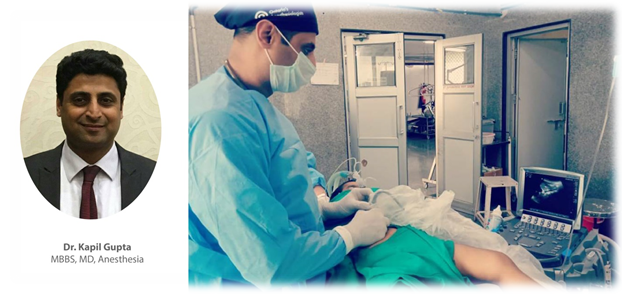
Dr. Kapil Gupta is a professor at the Anesthesia and Critical Care Department, Vardhman Mahavir Medical College and Safdarjung Hospital (VMMC & SJH), which is a 3500-bed multispecialty tertiary care government hospital in New Delhi, India. Dr. Gupta has over 18 years of professional experience in Anaesthesiology, Pain, and Perioperative Medicine as well as Intensive Care Unit and Trauma Center care experience.
Dr. Gupta has been using portable ultrasound systems in his clinical practice since 2010 and strongly believes that portable ultrasound is the best bedside tool for diagnosing various lung and cardiac abnormalities because it provides high sensitivity and specificity, without the patient needing to be transported to a CT/MRI suite which in turn helps provide immediate diagnosis and prompt patient care. Dr. Gupta highly regards Sonosite systems as being user friendly with simple, intuitive interfaces and quick boot up times, and finds it easy to perform procedures with enhanced needle visualization technology.
Dr. Gupta states:
“Sonosite ultrasound systems are widely accepted by anesthesiologists worldwide,
used to administer ultrasound guided nerve blocks and even difficult neuroaxial blocks.”
Since the beginning of his career, Dr. Gupta has been providing patient care with different Sonosite ultrasound systems and routinely employs portable ultrasound technology for inserting CVP lines, difficult arterial lines, and peripheral IV cannulas. In addition, he performs FAST exams with Sonosite ultrasound systems to locate the bleeding in trauma victims in emergency unit & ICU settings.
Most commonly, Dr. Gupta utilizes Sonosite ultrasound systems for performing lung ultrasound examinations (to diagnose lung pathologies in critically ill patients, including pulmonary edema, pneumothorax, pleural effusion and consolidation) and to perform Transthoracic Echocardiography for quick detection of the cause of hemodynamic instability including cardiovascular compromise, decreased cardiac contractility, regional wall motion abnormality, and an empty heart. In addition, he often utilizes Sonosite ultrasound devices for the measurement of Inferior Vena Cana diameter (to check collapsibility to elucidate the requirement of fluids in trauma victims in E-Med & ICU departments), and he also performs orbital and gastric ultrasound exams whenever or wherever required.
“I’ve been using ultrasound as the endpoint to rule out pulmonary edema in kidney transplant patients intraoperatively, states Dr. Gupta. Appearance of B lines in ultrasound lung is an indicator that interstitial fluid edema is developing resulting in no more fluids. Furthermore, for difficult arterial lines and peripheral IV cannulas, ultrasound is very useful. I do transthoracic echo in cardiac patients preoperatively to access fluid status, cardiac contractility as well as afterload.”
Dr. Gupta is quite passionate about providing educational training on the use of ultrasound in anesthesia and critical care and believes that Point of Care Ultrasound (POCUS) plays a vital role in deciding on the right patient care pathway and this technology should be adopted by all intensivists, emergency medicine physicians and anesthesiologists in their routine professional practice.



